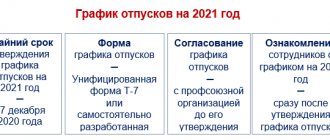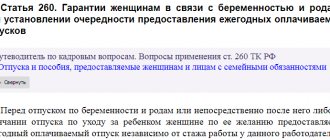What is rest time according to the Labor Code
Rest time for employees is defined as the period during which an employee can be released from duty.
During the period of such rest, a person has the right to engage in personal affairs, regardless of his location. This feature is due to the fact that types of rest time include time intervals that arise as a result of the rights granted to the employee by the employer. Below we will dwell in more detail on the features of existing types of rest time. Subject to the provisions of Art. 107 of the Labor Code of the Russian Federation, types of rest time include:
- day break;
- daily rest;
- weekend;
- days recognized as non-working days due to falling on holidays;
- vacation.
A selection of forms from ConsultantPlus will help you correctly arrange the provision of vacations. If you don't already have access to this legal system, get a trial access. It's free.
How to display vacation on the timesheet, read the article “Working time sheet on form T-12 - form.”
How to pay a fine for violating the driver’s work and rest schedule
It is not possible to pay a fine for violating the work and rest schedule with a 50% discount - only a deferment or installment plan of the fine is possible. Therefore, it is important to avoid violations.
You can find and pay a fine for violating the driver’s work and rest schedule on the websites of the State Traffic Safety Inspectorate, Rostransnadzor and the State Services portal. But if an organization has a large fleet of vehicles and a staff of drivers, you can find and pay all fines faster in the Online State Traffic Safety Inspectorate service: you don’t have to check each car and driver manually. The check is carried out automatically using the federal treasury database, which contains information on all fines of legal entities and individuals.
The service monitors the appearance of new car fines for the organization, notifies about them and payment deadlines in your personal account or via SMS.
Checking fines for legal entities
Find out if the organization has fines for violations of work and rest schedules
Try for free
Don't miss new useful publications
We will tell you about the intricacies of the legislation, help you understand it and tell you what to do in controversial situations.
How long is the break during the working day?
This type of rest can last from 30 minutes to 2 hours, while the exact period is established by the employer’s internal documents. The specified time is allocated so that employees can:
- take a little break from work;
- have lunch.
This break increases the length of the working day, since it is not included in the calculation of hours worked. Exceptions are cases when:
- working conditions do not allow organizing time for such rest;
- Work is carried out at low temperatures, and there is a need for periodic heating, for which appropriate rest time is allocated.
Is it possible to split breaks for rest and food? For the answer to this question from Rostrud, see ConsultantPlus. Trial access to the system is provided free of charge.
Classification of types of working time according to Labor Code
Working time should be understood as periods of working activity:
- with a standard duration of 8 hours;
- within the framework of reduced working hours;
- not completing the full scope of work;
- overtime work performed outside the standard;
- irregular working hours established by local regulations of the organization.
The Labor Code also includes other periods in the concept of working time, for example:
- breaks for rest and meals (lunch), when the employee cannot leave the place of work (in accordance with Article 108 of the Labor Code);
- breaks provided for in Article 109 of the Labor Code, which must be provided under certain conditions (working in the cold season in the open air or in unheated rooms) for rest and heating;
- time of separation from work for a woman breastfeeding.
Let us note that the employer is obliged to pay for the working time of each employee, including all overtime hours in excess of the normal shift duration and shortcomings caused by the employer.
What does daily rest mean?
Daily rest, or break, is carried out by each employee after the end of the working day. This rest period lasts until the start of the next working day. Thus, its duration depends on the work schedule provided for by the employer’s internal documents. For example, if the local document of the organization stipulates that the working hours are from 9:00 to 18:00, then rest lasts from 18:00 of the current day to 9:00 of the next day.
Note that the Labor Code of the Russian Federation provides for the concept of “overtime work,” which means performing work duties after the end of the working day.
More details about the features of overtime work and the rules for its compensation are described in the article “How is overtime work paid according to the Labor Code of the Russian Federation?” .
How to calculate salary for shift work
Let's look at an example.
The operational dispatcher has a summarized recording of working time with a recording period of 1 month. Work is carried out on a 2/2 schedule (2 working days of 11 hours each, followed by 2 days off).
According to the schedule, the dispatcher worked 165 hours for the month against the norm of 160 hours. The accountant made the following calculation (the hourly tariff rate of the dispatcher is 260 rubles):
- salary for hours worked: 165 hours × 260 rubles/hour = 42,900 rubles;
- processing hours: 165 – 160 = 5 hours;
- number of working days in the accounting period: 165 hours / 11 hours per shift = 15 days;
- calculation coefficient (average duration of overtime work per 1 working day of the accounting period): 5 hours / 15 days. = 0.33 hours/day. (does not exceed 2 hours a day, which corresponds to payment for overtime hours at one and a half times the rate);
- amount of additional payment for overtime work: 260 rubles/hour × 5 hours × (1.5 – 1) = 650 rubles;
- total salary: 42,900 + 650 = 43,550 rubles.
With the same approach, you can calculate differently:
- salary for standard hours: 160 hours × 260 rubles/hour = 41,600 rubles;
- additional payment for overtime: 5 hours × 260 rubles/hour × 1.5 = 1,950 rubles;
- total salary: 41,600 + 1,950 = 43,550 rubles.
The choice of calculation method does not affect the final result.
Rest time from Saturday to Monday is typical for all employers
Often, many employers offer work on a five-day basis, in which working days are Monday, Tuesday, Wednesday, Thursday, Friday, and Saturday and Sunday are weekends. But the Labor Code of the Russian Federation does not define these two days as days off. According to Art. 111 of the Labor Code of the Russian Federation, with a 5-day working week, employees are allocated 2 days off, with the obligatory day being Sunday. The second day off may also be Monday, which is stated in the employer’s internal documents.
If the employer is on a six-day working week, then he has one day off. In cases where work processes cannot be suspended for the “classic” weekend from Saturday to Monday, employees have the right to take a weekly rest on various days provided for by the schedule and internal documents of the employer.
In this case, the continuous duration of such rest should be at least 42 hours. Note that this period is also fixed in some provisions regulating working hours and rest. For example, such a requirement is contained in clause 26 of the Regulations on the peculiarities of the working hours and rest periods of car drivers, failure to comply with which may lead to the application of administrative liability to a legal entity in the form of a fine from 30,000 to 50,000 rubles. according to Art. 5.27 Code of Administrative Offenses of the Russian Federation.
Please note that the law defines a special procedure for paying for work on weekends.
Read more about this in our article.
Who controls the driver’s work and rest schedule and how?
The employer is obliged to monitor compliance with the work and rest schedule of drivers. All legal entities and individual entrepreneurs whose activities are related to the operation of vehicles must equip them with tachographs. Read more about which cars must have tachographs installed in our article.
A specially appointed specialist is responsible for working with tachographs in the organization. If this is not the case, then the responsibility falls on the manager. The driver must know how to use the tachograph, monitor its performance on the road and have instructions.
If the tachograph is broken, the driver can only continue driving towards the nearest service station or parking lot. The journey from the moment the device breaks down should not take more than 7 days. A list of workshops for the repair and maintenance of tachographs in the regions of Russia is on the Rosavtotrans website.
Traffic police and Rostransnadzor employees can check whether the car has a tachograph and its serviceability. There are fines for a faulty tachograph or its absence.
Which days are non-working holidays?
Taking into account the norms of Art. 112 of the Labor Code of the Russian Federation, holidays include:
- January 1–8;
- February 23;
- March 8;
- May 1 and 9;
- 12 June;
- November 4.
It is important to note that working on holidays has a number of nuances:
- Employees are allowed to work on such days only with their written consent.
- It is mandatory to draw up a written order from the manager.
- Some employees may work on public holidays only if not prohibited by medical advice. This:
- disabled people;
- mothers of children under 3 years old;
- pregnant women.
- for piecework work, payment is based on 2 times the piecework rate;
- when working at a tariff rate - at least 2 tariff rates;
- if there is a salary - from the salary rate (if the work is within the monthly norm according to the Labor Code), in double the amount (above the monthly norm).
Read about the peculiarities of working on holidays in this material.
What kind of holidays are there?
Types of rest time include vacation - this is the longest rest provided for by the Labor Code of the Russian Federation.
The Labor Code provisions provide the following leaves for employees:
- Annual paid leave - the minimum period of such leave is 28 days, however, some employers may provide longer leave if required by law.
- Annual additional paid leave - such leave can be used if the following conditions are met:
- employees are involved in harmful or dangerous working conditions - the duration of additional leave is from 7 days;
- employees work under special conditions - the duration of such leave is regulated by the employment contract;
- the work is due to an irregular schedule - in this case, 3 days or more can be added to the annual leave;
- work is carried out in the Far North or equivalent areas - vacation is 24 and 16 days, respectively;
- other conditions provided for by laws or local documents of the employer.
Annual and additional paid leave are planned by the employer for the next year 2 weeks before it begins and are approved in a special schedule. You can familiarize yourself with the nuances of drawing up the document in the article “Unified Form No. T-7 - Vacation Schedule.”
- Additional unpaid leave - provided to an employee for family reasons without pay; At the same time, the Labor Code of the Russian Federation identifies certain groups of persons to whom the employer does not have the right to refuse to provide such leave, for example:
- disabled people;
- pensioners;
- employees upon the birth of a child, marriage, death of a relative;
- in the presence of other reasons listed in Art. 128 Labor Code of the Russian Federation.
Results
As can be seen from the article, labor legislation provides for a wide range of possibilities for providing an employee with a break from performing his work duties. Moreover, the duration of such rest can be either minimal - 30 minutes, or longer, up to weeks if the employee exercises his right to leave.
Sources: Labor Code of the Russian Federation
You can find more complete information on the topic in ConsultantPlus. Free trial access to the system for 2 days.







